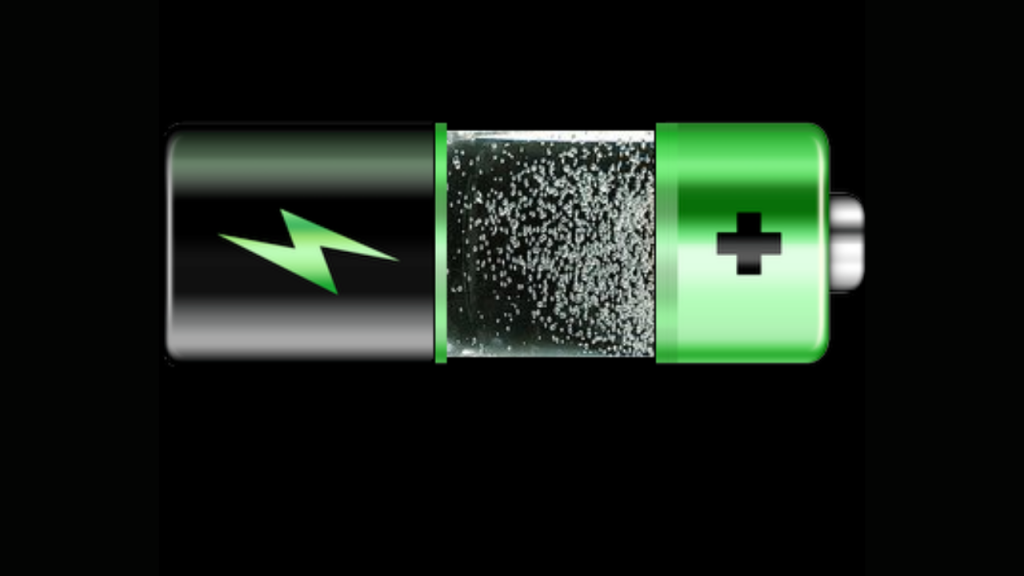😄 This gokart project is gonna be fun…We’re literally calling motor manufacturers and all and getting this planned out for you to enjoy. Vroom Vroom.
THE TL;DR 💨
🥼 Eliminating Hexavalent Chromium from the Coating Industry
- Current corrosion resistant coatings contain dangerous materials such as hexavalent chromium
- Removing the toxic part of current coatings and cleaning it up may result in longer lasting steel and coated materials
- Safer coating materials also assists in enabling safer work enviornments
🔋 Using Hydrilyte As The Chemistry For Long Duration Storage
- They utilize a liquid which they call Hydrilyte to store hydrogen for long duration storage applications
- They hope to provide “…the only intrinsically safe and non-toxic hydrogen storage solution that is scalable from kilowatt-hours to terawatt hours”
🚀 STARTUPS & TECH
Eliminating Hexavalent Chromium from the Coating Industry
By: Daniel Kriozere

Corrosion and wear are two major problems with manufacturing metals. The impacts of corrosion costs industry around $2.5T. Current solutions, such as hexavalent chromium and cadmium, are ineffective and dangerous. Creating a better solution for corrosion can protect the environment. A durable corrosion resistant coating can address all the issues enable the future. This is what Mehdi Kargar, CEO of Maxterials, is solving.
What problem are you solving?
The industry at large is dealing with the problem of wear and corrosion. Maxterial is making a longer lasting corrosion and wear-resistant coating, which is also not toxic (compared to the coatings used today – Hexavalent Chromium, Cyanide, and Cadmium). We started Maxterial to address these problems that we’ve known about for years. We have built our coating technology to provide a response to such a future need.
Our first product, MaxShield technology, is a coating that tolerates high temperatures, extreme corrosion, and wear. The advantage is that it can be applied to low-cost materials, such as steel, resulting in performance equivalent to expensive alloys. MaxShield was certified to be free of all substances of high concerns based REACH. The other technology in our pipeline is a corrosion-resistant coating for replacing Cadmium in electric connectors.
How have you thought about impact/impact metrics?
There are a few ways we are thinking about impact.
One aspect is getting rid of current toxic chemicals. It’s a very difficult one to get rid of these chemicals, like Hexavalent Chromium, Cyanide, and Cadmium. By eliminating the use of these toxic chemicals, we also have an impact on the safety of the workers in the production facility.
Maxterial also plays a role in reducing carbon footprint. We allow for materials, like steel, to last longer. This influences how often materials need to be replaced. For example, when we compare corrosion resistance between carbon steel coated with Maxterial’s product to carbon steel coated in chromium, our coatings extend the lifetime of the carbon steel by at least 40x. When you put chromium on carbon steel and leave it in a salt chamber, it corrodes after 400 hours, compared to Maxterial, where you will not see any corrosion after 5,000 hours of usage. Additionally, if aluminum is properly protected against corrosion and wear, it might be able to replace plastics already used in marine applications.
Maxterial also has an impact on cost. Superalloys, for example Hastelloy is expensive. Rather than making an entire part from these alloys, we can make the object from cheap materials, such as steel, and coat it with a microscopic tin coating. This way, we can reduce the cost of materials by 6-10X.
How does your coating compare to your competition?
The primary way Maxterial competes with current toxic chemicals is that we don’t have regulatory issues. A globally well-known firm has recently tested our coatings per REACH standards. The reports certified that our coatings are free from substances of high concern.
Our technology outperforms all competitors in corrosion protection, performance, and cost. Our product not only outperforms other solutions in corrosion and cost, but it can also operate at high temperatures and harsher environments.
What will drive the growth of non-toxic coatings?
One thing is certain, these toxic chemicals need to be eliminated from the market. Government and regulation will likely be the driver here. Regulatory bodies are calling to eliminate hexavalent chromium from the market by 2024. Regulation, along with price point will accelerate the adoption of toxic-free chemical coatings. Furthermore, future technologies such as 5G+, low-cost space systems and many other technologies, require access to low-cost yet high performance materials.
Outlook
Toxic-free coatings will continue to grow, from different coatings to different use cases. Maxterial’s coating technology can enable cheaper, safer and lighter materials for extreme environments. Such a technology can indirectly reduce the carbon footprint in multiple ways. The direct environmental impact Maxterial can have is by extending the lifetime of materials, in addition to improving the lives of laborers/manufacturers.
Sign up for The Impact and learn the perspectives behind the latest sustainability trends
🚀 STARTUPS & TECH
Helping Green Hydrogen grow with... Oil Storage Assets?
By Max Melnick

For most battery chemistries that are used at grid-scale, anything that is longer than 8 hours is considered long-duration storage. Imagine a community that has recently invested aggressively in wind and solar assets; without appropriate storage, the advantages of those assets are unlikely to be fully realized.
I grew up in a home situated in a rather secluded area, where power outages were a frequent occurrence. If my family found out that we only had hours left in our backup generator, we would hastily drive to the nearest gas station about 15 minutes away and refill every gas can we had. The uncertainty when you’re hours away from no power is palpable. At the community level, some believe a similar risk will develop without adequate planning and investment.
Background
I recently spoke to the CEO of Carbon 280, Mark Rheinlander, in order to understand his company’s vision for long-duration storage as well as Carbon 280’s technology and approach.
Carbon 280 has basically developed a liquid battery, except rather than holding energy in the traditional electrochemical sense (i.e. lithium-ion battery), they have developed a material called Hydrilyte, which enables them to store hydrogen in a mineral-based magnesium oil. It is one of the few technologies I have come across that manages to improve its storage capacity with each cycle rather than diminish, and CO2 is never emitted during their process.
After I started our interview, Mark sought to clarify the “Why” behind his business first and foremost. Carbon 280’s intention is baked into their name: they want to be part of the suite of solutions that help reduce society’s emissions and bring us back to pre-industrial concentrations of carbon in the atmosphere, which was about 280 parts per million. They have their sights set on the power system and energy exports for now, but if their vision comes to fruition the impact they could have on those markets alone may revolutionize our strategy for reaching a sustainable energy society.
Mark’s view on the battery market was troublesome to say the least. Currently, the amount of storage needed for communities running on wind and solar is “well beyond what is commercially viable for batteries…The longer the storage requirement in a community, the less economic traditional batteries become.”
Don’t Turn Your Back on Batteries
This isn’t to say that batteries don’t have a very clear and explicit purpose in the renewable power system. Batteries are incredibly valuable for storage periods less than 8 hours. In particular, they are fantastic at frequency response and providing stability against intermittency (i.e. time of use shift). But they struggle in providing the long-duration storage that will likely be needed to ensure that power needs can be met 99.7% of the time (3 sigma rule).
Take one look at the duck curve (example provided from California) and you will realize that an astounding amount of ancillary services will need to be provided in order to ensure a safe, reliable, and renewable grid.
Carbon 280’s Innovation
Carbon 280 has brought together a group of geologists, geophysicists, chemical engineers, and commercialization experts in order to scale their Hydrilyte hydrogen storage technology. Based on the recent IPCC report, we can’t afford to patiently explore the applications of technologies akin to Carbon 280’s. Luckily, their approach could help both communities investing in clean energy and those that own oil storage assets, a customer group that is rarely found alongside one another.
Their Hydrilyte material is a mineral oil that suspends magnesium particles that are about 10 micrometers in length. The oil they use in their material is never once combusted, and the Hydrilyte seems to increase its storage capacity with each successive hydrating and dehydrating cycle.
Standard design life for average mechanical systems is about 20 years, so Carbon 280 has taken this figure as an average length life for their systems without the certainty that comes with knowing this experimentally. The average grid-scale battery lasts between 5 and 15 years, so Carbon 280’s average lifespan is a notable increase in application life compared to the lifetime of grid-scale batteries. That said, the comparison may be moot considering that Carbon 280’s target market.
Target Market
Long duration storage at the community level as well as energy exports are the two markets that Carbon 280 hopes to position themselves in the coming years. And as it turns out, there are not really any existing solutions for either one of those that are economically sensible, particularly when you factor emissions into your calculations.
If you’re not near a hydropower plant, your options for long-duration storage are surprisingly limited.
Most people tend to gravitate towards cities, ergo, energy storage is moving into cities. There aren’t many commercially viable and safe options for long-duration storage in or near these highly populated areas. Assuming that emissions are part of the calculations, then it is likely hydrogen will likely be the contender to fill this market gap.
According to the CEO of Carbon 280, many commercially viable options for storing hydrogen present some avenue for significant danger if not managed incredibly well.
He noted that liquid and compressed hydrogen have the potential to be explosive. Not long ago we saw what happened in Beirut, Lebanon. Ammonia, toluene, and methylcyclohexane are all common yet incredibly toxic forms of hydrogen storage. It is unlikely that there is going to be a strong community backing for any of these potentially harmful storage applications.
As Mark stated rather emphatically that “Carbon 280 is the only intrinsically safe and non-toxic hydrogen storage solution that is scalable from kilowatt-hours to terawatt hours”.
Example Market Applications
Carbon 280 Could Have Prevented Disaster
Mark noted that he and his team did an internal evaluation on how their technology could have been applied to the energy disaster that occurred following a once-in-a-century storm in Texas. The energy shortage from the storm resulted in about $130 billion worth of costs for the utilities in that state. In Texas, there is a crude oil tank farm with nearly 2.1 million cubic meters of storage. If Carbon 280 had taken approximately 1.5 million cubic meters of that storage (~70%) and filled it with their Hydrilyte material, they could have covered that deficit and kept Texas free of power outages. Thereby avoiding a centi-billion-dollar disaster.
From the perspective of the community, the advantages are obvious. But what is also interesting is the fact that those that own oil storage assets may be able to leverage Carbon 280’s material as a way of maintaining the value of their infrastructure despite a declining need for oil.
Therefore rather than creating new technology, it may be a worthy avenue of exploration to look at companies akin to Carbon 280. This includes not only storage tanks but ships and trucks that are currently used in the oil storage supply chain. This enables oil companies to slow the declining value of oil infrastructure and leverage it for the new generation of clean energy storage. From a governmental perspective, it is much easier to take advantage of existing infrastructure than it is to build an entirely new set of assets.
Conclusion
Ultimately, it’s going to take companies like Carbon 280 to solve the climate crisis. Not only are they going to need to be companies that aggressively move away from oil, but there are also going to need to be companies that take advantage of the existing oil infrastructure for the purpose of increasing the adoption and integration of clean energy.
Writers: Swarnav S Pujari, Daniel Kriozere, Max Melnick
If you aren’t absolutely thrilled with The Impact, reply and let us know why. Or you can unsubscribe from all updates by clicking here.
Copyright © The Impact 2021. All Rights Reserved || 19 Morris Ave, Bldg 128, Brooklyn NY 11205

